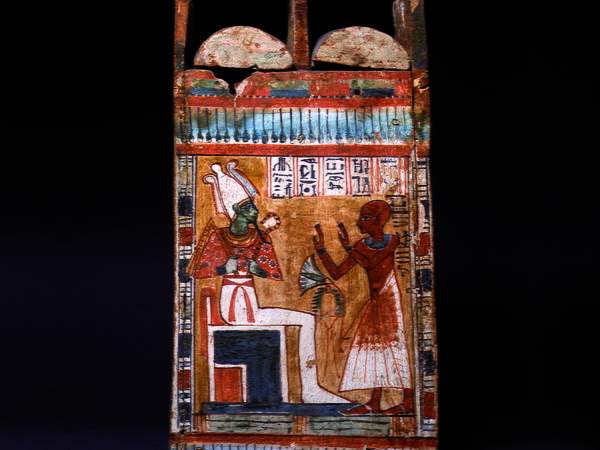Stefano Casciu, Director of the Polo Museale della Toscana, Maria Cristina Guidotti, Curator of the “Egyptian Museum” Section of the National Archaeological Museum in Florence, and Eugenio Martera, CEO and General Director of Contemporanea progetti s.r.l., yesterday presented the exhibition Mummies. Journey to Immortality, created by Contemporanea Progetti s.r.l., on display in the temporary exhibition spaces of the National Archaeological Museum in Florence from July 16, 2019 until February 2, 2020.
The exhibition project was born in 2000, from an idea of Maria Cristina Guidotti, who is also its scientific curator, on the occasion of a study on the mummies in the “Egyptian Museum” section of the National Archaeological Museum in Florence carried out by the University of Pisa. The exhibition, whose installation was curated by Contemporanea Progetti s.r.l., thanks to the contribution of Expona-museum exibition network has traveled extensively in Europe, touching Germany,Austria and Finland, and then, since 2018, to China, in the cities of Guiyang, Hefei, Ningbo, Xian and Jinan.
The more than one hundred exhibits, all belonging to the collections of the “Egyptian Museum” section in Florence, return today to their home, where the public will be able to admire the artifacts that were largely stored in the museum’s warehouses. The works on display, selected and organized to illustrate in various aspects the relationship of the ancient Egyptians with the afterlife, include pieces of great importance. These include the Padimut sarcophagus, characterized by a very rich decoration that distinguishes the sarcophagi of the XXI and XXII dynasties (1069 - 656 B.C.), which has never been exhibited and never been studied before the exhibition; the statue of the priest Henat, one of the few examples of a statue of a dignitary wearing a Persian robe, evidence of the period when Egypt was subjected to the powerful Persian empire (525 - 404 B.C.B.C.), as well as the mummified head recently subjected to X-ray and CT scan investigations that allowed the reconstruction of the face of the deceased /656 - 332 B.C.), and the ushabti box (small statues of the burial outfit) of Nekhtamontu (1550 - 1070 B.C.)
The exhibit illustrates the Egyptian concept of the life of the soul in the afterlife and the significance of all those objects that in ancient Egypt were routinely laid in tombs with the deceased. For the ancient Egyptians, in fact, death did not determine the end of life, but constituted a moment of transition to another form of existence, which continued in the afterlife. The soul, however, in order to continue living, needed a whole series of accouterments and objects that had to magically enable it to survive beyond death and, above all, it had to be reincarnated in its own body, which, for this reason, was best preserved through practices of embalming the corpse, which thus became a mummy. The topic, which is undoubtedly fascinating, is often treated by appealing to the idea of mystery and the more macabre aspects, spreading inaccurate ideas about Egyptian mummies.In the exhibition, on the other hand, the process of embalming bodies is presented from a scientific point of view, in a clear and understandable but no less interesting manner.
The exhibition is organized into two parts: the first dedicated to the concept of survival of the soul and the “mummification” of the body of the deceased, and the second part dedicated to the objects that accompanied the dead in the tomb. The latter is divided into two sections, in which are presented the objects of the trousseau that had exclusively a funerary function (stelae, ushabti, offering tables), and the objects of daily life that were to recreate in the tomb the lost existence of the deceased (clothing, jewelry, furniture of various kinds).
The collection of the “Egyptian Museum” in Florence is the second largest in Italy after that of the Egyptian Museum in Turin. It was formed mainly during the 19th century, following the famous Franco-Tuscan expedition of Ippolito Rosellini and Jean François Champollion.
In 1828, in fact, the first scientific expedition left for Egypt, whose main purpose was the documentation of Egyptian monuments, and which brought back a considerable amount of very important artifacts distributed between the Louvre and the Museum of Florence, to which belonged in particular the famous chariot found in a Theban tomb of the 18th dynasty (1550-1291 B.C.C.), a unique specimen that belonged to a wealthy private individual, and the bas-reliefs from the tomb of Sety I, one of the most beautiful and richly decorated in the Valley of the Kings.
The Egyptian Museum of Florence came into being about thirty years later, in 1856, at the convent of the Nuns of Foligno on Via Faenza. In 1880 the museum was moved to its present location, along with the Etruscan Museum: the task of the new layout was given to the young Egyptologist Ernesto Schiaparelli, who decorated it in the Egyptian style. In 1894 Schiaparelli was transferred to the Egyptian Museum in Turin, and the Florence Museum did not have a director for many years.
In 1939 the Museum received a gift from thePapyrological Institute of Florence of numerous artifacts from excavations in the cities of El Hibeh (mainly sarcophagi) and Antinoe (including the important collection of Coptic textiles).
Its collections currently number more than 15,700 objects, ranging from prehistoric to Coptic times, and from 11 rooms that were renovated four years ago when Florence hosted the 11th International Congress of Egyptologists.
For all information you can call +39 055 23575 or email pm-tos.musarchnaz-fi@beniculturali.it.
Pictured: ushabti box from Nekhtamontu, 1550-1070 BC.
Source: release
 |
| Mummies of ancient Egypt on display at Florence's National Archaeological Museum |
Warning: the translation into English of the original Italian article was created using automatic tools. We undertake to review all articles, but we do not guarantee the total absence of inaccuracies in the translation due to the program. You can find the original by clicking on the ITA button. If you find any mistake,please contact us.